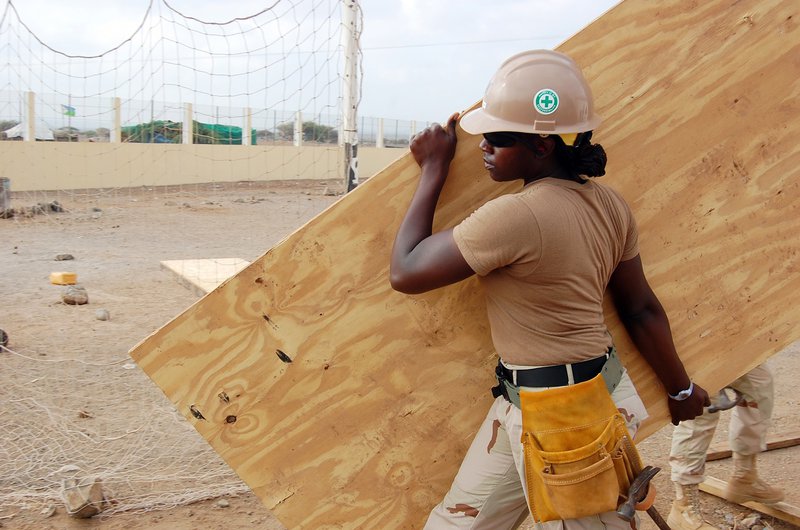Three Skilled Trades Work-Based Learning Programs for Youth in the DMV
Blog Post

Dec. 19, 2023
Earlier this year, NPR reported that the application rate for young people seeking jobs in the trades — like plumbing, building, and electrical work — dropped by 49% in 2022 compared to 2020. Jobs in these fields are in high demand and many come with good wages and benefits. To encourage teens to consider the skilled trades more seriously, school districts and their partners in the DC Metro Area (or the DMV, for the District of Columbia, Maryland, and Virginia) are creating more work-based learning opportunities in the skilled trades and construction industry. Here's a look at three programs aiming to replenish the skilled trades and construction workforce in the region:
Prince George’s County Public Schools’ Registered Youth Apprenticeship Program
Launched in 2019, the Prince George’s County Public Schools (PGCPS) Career and Technical (CTE) School to Work Apprenticeship program was the first of its kind in the state of Maryland. In collaboration with their Building Services Department, youth apprentices can receive paid, structured work-based learning (WBL) in construction and development. More specifically, students can participate in plumbing, electrical, carpentry, masonry, and HVAC.
PGCPS’ “School to Work” model for apprentices is a registered apprenticeship that starts while the apprentices are in high school and is completed after graduation. The county offers apprenticeships in multiple occupations, including two focused on construction:
- Construction Trades Program: Students start the program in 11th grade and can complete a 2-year pathway in plumbing, electrical, carpentry, masonry, or HVAC. Under this program, students can apply for apprenticeships while completing courses such as construction core, electrical 1 and 2, plumbing 1 and 2, HVAC 1 and 2, or Carpentry 1 and 2, and complete a minimum of 450 hours of on-the-job training (OJT) starting the summer prior to their senior year. Once students complete their program, they will receive a National Center for Construction Education and Research Industry Certificate (NCCER). Also, once students have completed their coursework, OJT hours, and graduated from high school, they can be hired as full-time employees/apprentices to complete the remaining related instruction (RI) courses and OJT hours to obtain their journeyperson’s license in their trade.
- Construction Design Management (CDM): Students start the program in 10th grade to complete the 3-year pathway. Some of their courses include Introduction to Construction Design and Management, Principles of Construction Design, and Advanced Construction Management. By the end of their program, students l earn a Revit and AutoCAD certification.
Fairfax County Public Schools’ Trades for Tomorrow Program
Fairfax County Public Schools (FCPS) created a “Grow Your Own” initiative that provides work-based learning opportunities to students who are interested in careers that are in-demand at the school district, including teaching positions, facilities roles, and other jobs in operations. Through the Grown Your Own initiative, FCPS created Trades for Tomorrow (T4T) in collaboration with Facilities and Transportation, Human Resources, Adult and Community Education (FCPS ACE), and Career and Technical Education (CTE). T4T creates a direct pipeline to fill the anticipated workforce shortages while providing students with robust work-based learning opportunities in the trades.
To begin, students must register as a Youth Registered Apprentice (YRA) with the State of Virginia’s Department of Labor. YRAs are career preparation and work-based learning programs that integrate CTE curriculum and paid on-the-job training (OJT) to help students gain employability and occupational skills.
Once students register as YRAs, and if they are interested in skilled trades and construction occupations, such as electrical and HVAC, they become eligible to earn OJT through the T4T Program as paid employees. After graduating from high school, many students transition from the YRA program to FCPS’ ACE registered apprenticeship program with the hopes of becoming licensed journeypersons.
Although the T4T program provides students with positive first moments in the trades field, future program development will depend on establishing sustainable pathways to enter the workforce after completing courses.
DC Students Construction Trades Foundation ACAD Builds Program
In collaboration with the DC Public Schools and Career and Technical Education, the DC Students Construction Trades Foundation supports the Academy of Construction and Design (ACAD Builds) internship program at Cardozo Education Campus.
ACAD Builds provides 12th-grade students in DC Public and Charter Schools, a chance to earn industry-recognized credentials in carpentry, electrical, HVAC, and plumbing pathways. The foundation offers numerous levels of classroom-related instruction to help students and their respective employers meet educational and professional development goals. As a part of the ACAD Builds program, the foundation offers scholarships and job placement support for all academy students.
When the foundation launched in 2005, there were only 43 students in the initial ACAD Builds cohort; however, now, the academy enrolls more than 100 students per academic year. Students in the ACAD Build program have a 90 percent high school graduation rate at their respective high schools, leading to one-third of graduates securing a skilled trades industry job and becoming eligible for additional training to become a journey craft professional.
These programs are just three of many opportunities in the DMV that provide young adults an opportunity to earn-and-learn as they prepare to launch careers in the skilled trades. Still, with persistent shortages, there is room for education providers, employers, labor unions and other partners in the DMV to further expand collaboration to expose more young people to high quality training and career opportunities that exist in the skilled trades.